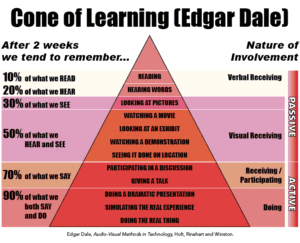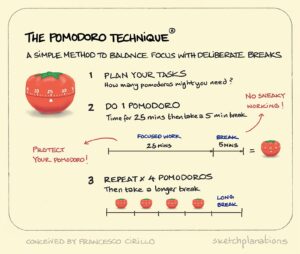Marshall McLuhan states in his Understanding Media: The Extensions of Man, published in 1964, with the phrase “The medium is the message”, that the form of a message (print, visual, musical, etc.) determines the ways in which that message will be perceived. McLuhan argued that modern electronic communications (including radio, television, films, and computers) would have far-reaching sociological, aesthetic, and philosophical consequences, to the point of actually altering the ways in which we experience the world, including learning experiences. And these experiences are dependent on many contexts as well as the media involved.
Edgar Dale’s Learning Experience Pyramid or Memory Cone (Dale, 1946) is often used by educators to plan learning experiences that take advantage of the most effective learning environments. This model divides multimedia elements into categories based on their “concreteness.” This refers to the ability of multimedia elements to avoid abstractness and to capture reality with varying degrees of realness.

Although the learning pyramid seems scientific, it lacks any empirical background and remains a thesis. It all probably started in 1937 with the work “Visualizing the Curriculum” by Hoban et al. (1937), who clarified different levels of abstraction. Based on this, Dale probably developed the Cone of Experience. However, the theoretical model did not specifically map learning behavior or memory performance. And for the percentages of the model, no corresponding empirical findings can be found to support these values. The legendary learning pyramid is indeed descriptive and looks good in lectures and presentations, but it is and remains one thing above all: a myth.
Therefore, the distinction between active and passive learning must be much more simplified on the basis of cognitive activation. Active learning is learner-centered; passive learning is teacher-centered. Active learning requires learners to think, discuss, question, and analyze information. Passive learning requires learners to take in, assimilate, consider, and translate information 1:1. Conversation and discussion promote active learning while listening and attention to detail promote passive learning.
Regarding didactics, both should be used in everyday classroom instruction. There are situations where learners need to be overwhelmed with as many facts as possible in order to be able to grasp the context later on, and situations where they are allowed to deal with the details and take up a lot of time.

An effective method to keep active while learning is using the pomodoro technique. Named after a pomodoro (tomato) kitchen timer, the essence of it involves considering in advance how many pomodoros you might need for what you want to get done, setting your timer for, normally, 25 minutes, and then focusing on your task until the time’s up. Then take a 5 minute break. That’s one pomodoro. After you’ve done four pomodoros take a longer break, of about 30 minutes.
Questions for the BAUG Brown Bag
The key questions for the brown bag series are:
- What is the percentage of active learning in the lecture?
- In which situations?
- What about the time structure? p.e. the pomodoro technique?
References
- Dale, Edgar. “The cone of experience.” Audio-visual methods in teaching 1 (1946): 37-51.
- Hoban, Charles F., Charles F. Hoban Jr, and Samuel B. Zisman. “Visualizing the Curriculum, New York, The Cordon Company.” (1937): 9.
Related Work
- Difference between Active Learning and Passive Learning
- The medium is the message
- https://principledesign.com.au/journal/the-medium-is-the-message/
- https://www.harapnuik.org/?p=7239
